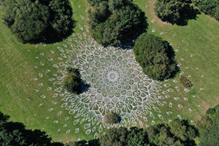Mandala Art
Context
India’s Mandala art, which has its roots in ancient philosophy, is now getting famous worldwide. In a recent event, a spectacular ‘Mandala’ art installation, The Knowsley Mandala, was unveiled in the United Kingdom (Liverpool).
Background
- The art is believed to be rooted in Buddhism, appearing in the first century BC in India.
- Over the next couple of centuries, Buddhist missionaries travelling along the Silk Road took it to other regions.
- In Hinduism, the mandala imagery first appeared in Rig Veda (1500 – 500 BCE).

|
In Buddhism, the Sand Mandala painting originated in Vajrayana Buddhism for meditative purposes. |
Analysis
What is a Mandala?
- In the ancient Sanskrit language of Hinduism and Buddhism, mandala means “circle.”
- Traditionally, a mandala is a geometric design or pattern that represents the cosmos or deities in various heavenly worlds.
- A mandala is a spiritual and ritual symbol in Asian cultures.
|
Mandala in Hinduism & Buddhism:
|
Mandala art therapy
- Mandala art therapyis a kind of psychotherapy.
- This therapy is used in treating depression, post-traumatic stress disorder, grief, anger management, improving self-esteem, management of addictions, relieving stress, improving symptoms of anxiety, and coping with any kind of physical illness or disability.
Symbolism in Mandalas
|
Wheel with eight spokes (Dharmachakra) |
The circular nature of a wheel works as an artistic representation of a perfect universe. The eight spokes represent the Eightfold Path of Buddhism, a summary of practices that lead to liberation and rebirth. |
|
Bell
|
Bells represent openness and emptying of the mind to allow the entrance of wisdom and clarity. |
|
Triangle |
When facing upward, triangles represent action and energy, and when facing downward, they represent creativity and the pursuit of knowledge. |
|
Lotus flower |
A sacred symbol in Buddhism, the symmetry of a lotus depicts balance. As a lotus reaches up from underwater into the light, so too does a human reaching for spiritual awakening and enlightenment. |
|
Sun |
A popular basis for modern mandala patterns, suns tend to represent the universe, often carrying meanings related to life and energy. |
|
Fun exercise
|









